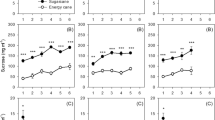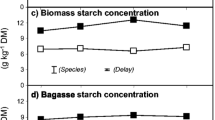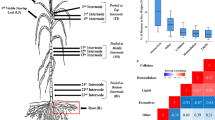Abstract
Sugarcane grows on over 170,000 ha in the state of Louisiana as part of a sugar industry that generates over $2 billion in annual economic impact. The multipurpose crop produces sugar, molasses, bagasse, boiler fly ash, filter press mud, water, and electricity. As a component of a theoretical bioenergy economy, bagasse and sugarcane itself may find a value-added niche as a renewable feedstock source. The objectives were to characterize yields of ‘Ho 02-113’ at two locations over 2 years and compare two harvest strategies, green-cane harvest (stalks-only), or complete biomass harvest (intact plants). The first- and second-ratoon crop and the plant-cane and first-ratoon crop were harvested monthly at the Ardoyne Farm or Spanish Trail, respectively. Total biomass yields of 120 Mg ha−1 and up to 35 Mg dry matter (DM) ha−1 at the Ardoyne Farm and total biomass > 140 Mg ha−1 and 50 Mg DM ha−1 at Spanish Trail were observed. Sucrose levels ranging from 2000 to 8000 kg ha−1 were recorded between August and September of each year. However, freezing conditions rapidly reduced sucrose levels from as high as 12,000 kg ha−1 to below detection limits within 60 days. Dry matter energy content of intact plants, stalks, and dry leaves was 17.0, 17.4, and 16.5 kJ g−1, respectively. The overall energy yields were 530 and 620 GJ ha−1 for the Ardoyne Farm and Spanish Trail, respectively. Results demonstrate that Ho 02-113 is a versatile feedstock and can meet sucrose and/or lignocellulosic feedstock needs in areas with temperate to subtropical temperatures.








Similar content being viewed by others
References
Kim M, Day DF (2011) Composition of sugar cane, energy cane, and sweet sorghum suitable for ethanol production at Louisiana sugar mills. J Ind Microbiol Biotechnol 38(7):803–807. https://doi.org/10.1007/s10295-010-0812-8
Lima IM, White PM Jr (2017) Sugarcane bagasse and leaf residue biochars as soil amendment for increased sugar and cane yields. Int Sugar J 119(1421):382–390
Webber CL III, White PM Jr, Spaunhorst DJ, Petrie EC (2017) Impact of sugarcane bagasse ash as an amendment on the physical properties, nutrient content and seedling growth of a certified organic greenhouse growing media. J Agric Sci 9(7):1. https://doi.org/10.5539/jas.v9n7p1
USEPA (2007) Summary of the energy independence and security act. Available online at: https://www.epa.gov/laws-regulations/summary-energy-independence-and-security-act. (Accessed in May 8, 2018).
Angelini LG, Ceccarini L, Nassi o Di Nasso N, Bonari E (2009) Comparison of Arundo donax L and Miscanthus x giganteus in a long-term field experiment in Central Italy: analysis of productive characteristics and energy balance. Biomass Bioenergy 33:635–643
Arundale RA, Dohleman FG, Heaton EA, McGrath JM, Voigt TB, Long SP (2014) Yields of Miscanthus x giganteus and Panicum virgatum decline with stand age in the Midwestern USA. GCB Bioenergy 6:1–13. https://doi.org/10.1111/gcbb.12077.
Palmer IE, Gehl RJ, Ranney TG, Touchell D, George N (2014) Biomass yield, nitrogen response, and nutrient uptake of perennial bioenergy grasses in North Carolina. Biomass Bioenergy 63:218–228
Rocha JR, Machado JC, Carneiro PC, Carneiro J, Resende MDV, Pereira AV, Carneiro JE (2017) Elephant grass ecotypes for bioenergy production via direct combustion of biomass. Ind Crop Prod 95:27–32. https://doi.org/10.1016/j.indcrop.2016.10.014
Eggleston G, Legendre BL (2003) Mannitol and oligosaccharides as new criteria for determining cold tolerance in sugarcane cultivars. Food Chem 80:451–461
Chynoweth DP, Turick CE, Owens JM, Jerger DE, Peck MW (1993) Biochemical methane potential of biomass and waste feedstocks. Biomass Bioenergy 5:95–111
Tew TL, Cobill RM (2008) Genetic improvement of sugarcane (Saccharum spp.) as an energy crop. In: Vermerris W (ed) Genetic improvement of bioenergy crops. Springer, NYC, pp 249–272
Knoll JE, Anderson WF, Richard EP Jr, Doran-Peterson J, Baldwin B, Hale AL, Viator RP (2013) Harvest date effects on biomass quality and ethanol yield of new energycane (Saccharum hyb.) genotypes in the Southeast USA. Biomass Bioenergy 56:147–156
Legendre BL (1975) Ripening of sugarcane: effects of sunlight, temperature, and rainfall. Crop Sci 15:349–352
Mitchell RB, Schmer MR, Anderson WF, Jin V, Balkcom KS, Kiniry J, Coffin A, White PM (2016) Dedicated energy crops and crop residues for bioenergy feedstocks in the central and eastern USA. Bioenergy Res 9:384–398
Hale AL, Dufrene EO, Tew TL, Pan Y-B, Viator RP, White PM, Veremis JC, White WH, Cobill R, Richard EP Jr, Rukavina H, Grisham MP (2012) Registration of ‘Ho 02-113’ sugarcane. J Plant Regist 7(1):51–57
Kandasami PA, Sreenivasan TV, Ramana Rao TC, Palanchami K, Natarajan BV, Alexander KC (1983) Catalog on sugarcane genetic resources 1. Saccharum spontaneum L. Sugarcane Breeding Institute, Indian Council Agricultural Research. Seshan Printers, Coimbatore
Milligan SB, Martin FA, Bischoff KP, Quebedeaux JP, Dufrene EO, Dufrene EO, Quebedeaux KL, Hoy JW, Reagan TE, Legendre BL, Miller JD (1994) Registration of ‘LCP 85-384’ sugarcane. Crop Sci 34(3):819–820
Mehlich A (1984) Mehlich 3 soil test extractant: a modification of Mehlich 3 extractant. Commun Soil Sci Plant Anal 15(12):1409–1416
Brown, S, David, J, Diaz, R, Foil, LD, Healy, K, Huang, F, Reagan, T, Moshman, L, Ring, D, Schowalter, T, Stout, M, Smith, T, Wilson, B (2018) Louisiana insect pest management guide. Louisiana State University Agricultural Center. Available online at: http://www.lsuagcenter.com/~/media/system/4/9/6/c/496c381f03be739dc3d77b0a1a893309/pub1838_2018lainsectpestmgmtguidepdf.pdf. (Assessed May 8, 2018)
Lofton J, Tubaña BS, Kanke Y, Teboh J, Viator H, Dalen M (2012) Estimating sugarcane yield potential using an in-season determination of normalized difference vegetative index. Sensors 12(6):7529–7547
Meade GP, Chen JCP (1977) Cane sugar handbook. New York, Wiley
SAS Institute (2008) SAS for Windows. Ver 9.2. Cary, NC
Viator RP, Richard EP Jr (2012) Sugar and energy cane date of planting effects on cane, sucrose, and fiber yields. Biomass Bioenergy 40:82–85
Legendre BL, Burner DM (1995) Biomass production of sugarcane cultivars and early-generation hybrids. Biomass Bioenergy 8(2):55–61
Giamalva MJ, Clarke SJ, Stein JM (1984) Sugarcane hybrids of biomass. Biomass 6:61–68
Bischoff KP, Gravois KA, Reagan TE, Hoy JW, Kimbeng CA, LaBorde CM, Hawkins GL (2008) Registration of ‘L 79-1002’ sugarcane. J Plant Regist 2:211–217
American Sugar Cane League, Inc., of the U.S.A. (2018) Louisiana sugarcane industry production data 1975–2016. http://amscl.org/Images/Interior/sugar%20industry%20pamphlet/industryproductiondata1975–2016.pdf (Accessed May, 7 2018)
Zhao D, Irey M, LaBorde C, Hu C-J (2017) Identifying physiological and yield-related traits in sugarcane and energy cane. Agron J 109(3):927–937
Lee DK, Aberle E, Anderson EK, Anderson W, Baldwin BS, Baltensperger D, Barrett M, Blumenthal J, Bonos S, Bouton J, Bransby DI, Brummer C, Burks PS, Chen C, Daly C, Egenolf J, Farris RL, Fike JH, Gaussoin R, Gill JR, Gravois K, Halbleib MD, Hale A, Hanna W, Harmoney K, Heaton EA, Heiniger RW, Hoffman L, Hong CO, Kakani G, Kallenbach R, Macoon B, Medley JC, Missaoui, Mitchell R, Moore JK, Morrison JI, Odvody GN, Richwine JD, Ogoshi R, Parrish JR, Quinn L, Richard E, Rooney WL, Rushing JB, Schnell, Sousek M, Staggenborg SA, Tew T, Uehara G, Viands DR, Voigt T, Williams D, Williams L, Wilson LT, Wycislo A, Yang Y, Owens V (2018) Biomass production of herbaceous energy crops in the United States: field trial results and yield potential maps from the multiyear regional feedstock partnership. Glob Change Biol Bioenergy. https://doi.org/10.1111/gcbb.12493
Heaton EA, Dohleman FG, Long SP (2008) Meeting US biofuel goals with less land: the potential of Miscanthus. Glob Chang Biol 14:200–2014
Koide, RT, Nguyen BT, Skinner, RH, Dell, CJ, Adler, PR, Drohan, PJ, Licht, M, Matthews, MB, Nettles, R, Ricks, K, Watkins, J (2018) Comparing biochar application methods for switchgrass yield and C sequestration on contrasting marginal lands in Pennsylvania, USA. Bioenergy Res online 25 September 2018.
Kiesel A, Nunn C, Iqbal Y, Van der Weijde T, Wagner M, Özgüven M, Tarakanov I, Kalinina O, Trindade LM, Clifton-Brown J, Lewandowski I (2017) Site-specific management of Miscanthus genotypes for combustion and anaerobic digestion: a comparison of energy yields. Front Plant Sci 8. https://doi.org/10.3389/fpls.2017.00347
Heaton EA, Voigt T, Long SP (2004) A quantitative review comparing the yields of two candidate C4 perennial biomass crops in relation to nitrogen, temperature and water. Biomass Bioenergy 27:21–30
Li M, Liang Z, He S, Zeng Y, Jing Y, Fang W, Wu K, Wang G, Ning X, Wang L, Li S, Tan H, Tan F (2017) Genome-wide identification of leaf abscission associated microRNAs in sugarcane (Saccharum officinarum L.). BMC Genomics 18:754
Wu L, Li Y, Arakane M, Ike M, Wada M, Terajima Y, Ishikawa S, Tokuyasu K (2011) Efficient conversion of sugarcane stalks into ethanol employing low temperature alkali pretreatment method. Bioresour Technol 102:11183–11188
Steinbach D, Kruse A, Sauer J, Vetter P (2018) Sucrose is a promising feedstock for the synthesis of the platform chemical hydroxymethylfurfural. Energies 11(3):645. https://doi.org/10.3390/en11030645
Runge CJ, Sheehan JJ, Senauer B, Foley J, Gerber J, Johnson JA, Polasky S, Runge CP (2012) Assessing the comparative productivity advantage of bioenergy feedstocks at different latitudes. Environ Res Lett 7. https://doi.org/10.1088/1748-9326/7/4/045906
Borak B, Ort DR, Burbaum JJ (2013) Energy and carbon accounting to compare energy crops. Curr Opin Biotechnol 24(3):369–375
Shield IF, Barraclough TJP, Riche AB, Yates NE (2014) The yield and quality response of the energy grass Miscanthus x giganteus to fertiliser applications of nitrogen, potassium, and sulphur. Biomass Bioenergy 68:185–194
Ekefre DE, Mahapatra AK, Latimore M Jr, Bellmer DD, Jena U, Whitehead GJ, Williams AL (2017) Evaluation of three cultivars of sweet sorghum as feedstocks for ethanol production in the Southeast United States. Heliyon 3(12):e00490. https://doi.org/10.1016/j.heliyon.2017.e00490
Varvel GE, Vogel KP, Mitchell RB, Follet RF, Kimble JM (2008) Comparison of corn and switchgrass on marginal soils for bioenergy. Biomass Bioenergy 32:18–21
Acknowledgements
The authors would like to thank Christopher Adams, Lionel Lomax, Trevis Olivier, Halley Burleson, and Kelvin Lewis for field and laboratory assistance. Deborah Boykin provided indispensable statistical consultation. The United States Department of Agriculture (USDA) Agricultural Research Service, Sugarcane Research Unit in Houma, LA, provided funding, land, and laboratory space for the project. An Agriculture and Food Research Initiative (AFRI) Competitive Grant, No. 2011-69005-30515, from the USDA National Institute of Food and Agriculture, provided funding for personnel (C. Adams). Mention of trade names or commercial products is solely for providing specific information and does not imply recommendation or endorsement by the USDA. The USDA is an equal opportunity provider and employer.
Author information
Authors and Affiliations
Corresponding author
Rights and permissions
About this article
Cite this article
White, P.M., Webber, C.L., Viator, R.P. et al. Sugarcane Biomass, Dry Matter, and Sucrose Availability and Variability When Grown on a Bioenergy Feedstock Production Cycle. Bioenerg. Res. 12, 55–67 (2019). https://doi.org/10.1007/s12155-018-9951-y
Published:
Issue Date:
DOI: https://doi.org/10.1007/s12155-018-9951-y




